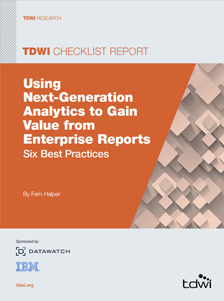
TDWI Checklist Report | Using Next-Generation Analytics to Gain Value from Enterprise Reports: Six Best Practices
April 9, 2014
Data can be a competitive differentiator for many companies.
Although much attention has been focused on structured data in
data warehouses, the reality is that valuable data about a company’s
business and its customers is found in reports as well as in less-than-structured documents. Often this kind of data is stored in a
company’s enterprise content management (ECM) system. An ECM
system is a way to collect, store, and organize company documents
and other sources of information. For instance, content management
systems often contain huge amounts of customer-facing reports, such
as financial statements, billing invoices, healthcare patient records, or
statements of benefits. These reports typically include numerical data.
The key to gaining value from this data is the ability to analyze it
and ultimately act on that analysis. However, although ECM systems
are helpful for storing and even classifying information, they often
fall short when extracting data on the reports for analysis. Too often,
this content is stuck in a content management system, and the only
way to analyze it is to either perform some sort of screen scraping
or manually enter the data while culling through all the reports.
Not only is this time-consuming and error prone, but it can also be
overwhelming.
New techniques are emerging to help business analysts automate the
extraction of information from reports stored in ECM systems and use
it for analysis. Some vendors refer to this as report mining: extracting
useful insight by analysis of the content found in reports. Such report
analysis can help open analytics to a new group of users and spread
the culture of analytics within the organization.
This Checklist Report focuses on helping organizations understand how
to get started with report analysis; including:
- Understanding the value of analytics
- Viewing your ECM as a report warehouse
- How to think through analyzing content from reports